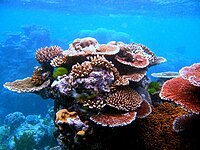
Photo from wikipedia
Madagascar is a major hotspot of biodiversity in the Western Indian Ocean, but, as in many other regions, coral reefs surrounding the island confront large-scale disturbances and human-induced local stressors.… Click to show full abstract
Madagascar is a major hotspot of biodiversity in the Western Indian Ocean, but, as in many other regions, coral reefs surrounding the island confront large-scale disturbances and human-induced local stressors. Conservation actions have been implemented with encouraging results for fisheries, though their benefit on coral assemblages has never been rigorously addressed. In this context, we analyzed the multiscale spatial variation of the composition, generic richness, abundance, life history strategies, and cover of coral assemblages among 18 stations placed at three regions around the island. The potential influences of marine protected areas (MPAs), algal cover, substrate rugosity, herbivorous fish biomass, and geographic location were also analyzed. Our results highlight the marked spatial variability, with variation at either or both regional and local scales for all coral descriptors. The northeast coastal region of Masoala was characterized by the high abundance of coral colonies, most notably of the competitive Acropora and Pocillopora genera and stress-tolerant taxa at several stations. The southwest station of Salary Nord was distinguished by lower abundances, with depauperate populations of competitive taxa. On the northwest coast, Nosy-Be was characterized by higher diversity and abundance as well as by high coral cover (~42–70%) recorded at unfished stations. Results clearly underline the positive effects of MPAs on all but one of the coral descriptors, particularly at Nosy-Be where the highest contrast between fished and unfished stations was observed. Biomass of herbivorous fishes, crustose coralline algae cover, and substrate rugosity were also positively related to several coral descriptors. The occurrence of reefs with high diversity, abundance, and cover of corals, including the competitive Acropora, is a major finding of this study. Our results strongly support the implementation of locally managed marine areas with strong involvement by primary users, particularly to assist in management in countries with reduced logistic and human resources such as Madagascar.
Journal Title: PLoS ONE
Year Published: 2022
Link to full text (if available)
Share on Social Media: Sign Up to like & get
recommendations!